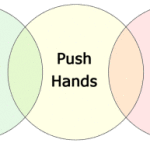 Tai Chi is often viewed as a solitary exercise. When most people hear the name the picture someone moving slowly through the sets, but while there are many exercises not all of them are solo exercises. The reason for this is simple: Balance and harmony. Solo form teaches students to get in touch with their inner energy pathways, understand and manipulate them. Solo form allows us to communicate with our body in new ways.
Tai Chi is often viewed as a solitary exercise. When most people hear the name the picture someone moving slowly through the sets, but while there are many exercises not all of them are solo exercises. The reason for this is simple: Balance and harmony. Solo form teaches students to get in touch with their inner energy pathways, understand and manipulate them. Solo form allows us to communicate with our body in new ways.
Tai Chi is more than a solo exercise however. Tai Chi Push Hands allows practitioners to extend their understanding of energy from another person's body. This give and take teaches students the true meaning of "full" versus "empty". One of the most basic sets in Tai Chi is the empty leg set. In this exercise students slowly shift their weight from both legs to a single leg, "emptying" the other of the sense of weight. When we practice Push Hands we are able to extend that sense to another person by engaging in contact.
There are a number of benefits that come from engaging with another person when you are practicing Tai Chi.
- It improves our understanding of both the concepts of empty and full in our solo practice by using opposing force.
- It improves balance.
- Strength training.
- Improvements in both martial and sports performances.
Push Hands is simple to understand but difficult to perfect. It requires remaining balanced, focused and relaxed while in contact with another. The process is simple:
- Two people stand face to face, with the same foot forward, at arm's length.
- Raise hands to chest height, palm facing in and the back of the hand slightly touching the other person's hand in the same spot.
- Place the rear hand gently on the elbow of your opponent, putting both of you in an equal position.
- Each person should feel balanced as the exercise begins.
- Opponents will then move their arms, waist and legs in harmony with each other with a circular pattern for three rotations, while at the same time remaining perfectly balanced.
- Once the rotations are completed each person will attempt to unbalance the other by pushing or pulling gently.
- You must be able to keep your feet in place and, at the same time, not use brute force to unbalance your opponent and never losing contact with your opponent.
The last part is probably the most important because if you lose contact with your opponent you lose the ability to sense the direction of their energy flow. This is where a thorough understanding of the principle of "Empty versus Full" comes into play. When you use one side of your body to create a pressure, this is called the "full" side and your opponent must answer by emptying that side of their body so that your force is redirected, literally channeled through your opponent and right back to you, unbalancing you on your empty side.
Push hands gives students the opportunity to test and improve their balance, flexibility and poise while at the same time relaxing and relieving distracting stress. This is a gentle way to compete and to test your abilities against someone else without risking injuries common in most martial arts sparring sessions without injury.
